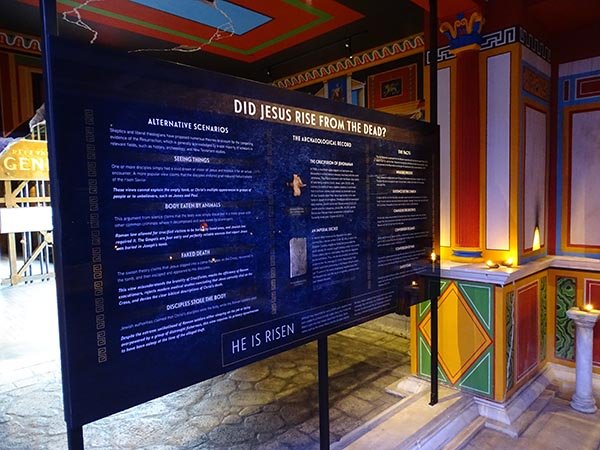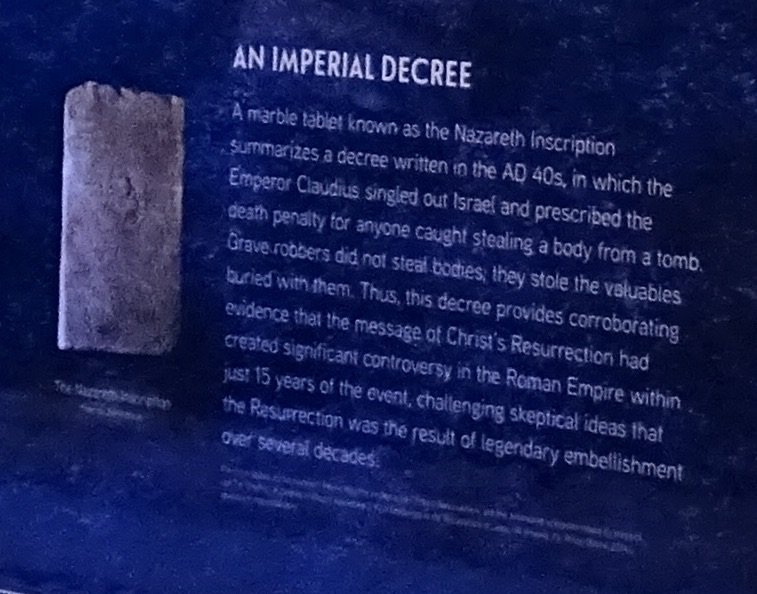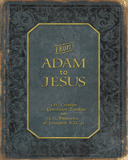
Nazareth Inscription Study Debunks Evidence for Christ’s Resurrection?
A marble tablet housed in the French National Library, measuring approximately 23.5 in. x 14.8 in. x 2.4 in., has drawn significant attention in recent weeks. Known as the Nazareth Inscription (or Nazareth Tablet), it has been cited as potential archaeological evidence for the biblical accounts of Christ’s resurrection. However, recent reports boldly proclaimed that this tablet is unrelated to early Christianity. Consider the following headlines.
Recent reports boldly proclaimed that this tablet is unrelated to early Christianity.
Newsweek announced, “Nazareth Tablet has Nothing to Do with Jesus, Belonged to Greek Tyrant, Scientists Say.” The Times of Israel declared, “Hi-tech test shatters claim ancient inscription is 1st proof of Christianity.”
Meanwhile, other outlets were a little more careful in their description.
The Smithsonian Magazine’s website informed its readers that “New Analysis Refutes Nazareth Inscription’s Ties to Jesus’ Death” while Live Science’s headline read, “Was the 'Nazareth Inscription' a Roman response to Jesus' empty tomb? New evidence says it wasn't.”
Perhaps the most guarded headline came from Science News: “The Nazareth Inscription’s origins may refute ties to Jesus’ resurrection.”
What is all the hype about? What is the Nazareth Inscription and why has it been tied to Jesus? What is this new evidence touted by media outlets that “shatters” the link to early Christianity? How should Christians view the Nazareth Inscription and these claims about it? This article will address these questions in order.
The Nazareth Inscription
The potential connection to Christianity has made this tablet a very important discovery. Wilhelm Froehner acquired it in 1878. Unfortunately, this was before the establishment of careful documentation related to archaeological finds. His notes about it state only that it was “sent from Nazareth.” Of course, this is the town where Jesus grew up and lived for much of his earthly life. There are 22 lines of Greek text written on the front in majuscule characters (capital letters). The text claims to be a “Decree of Caesar” (diatagma Kaisaros) and prescribes the death penalty for anyone who would remove bodies from tombs with wicked intent. It also mentions sepulchral stones, which are primarily found in Israel. Many researchers believe that the “Caesar” who sent this rescript (an imperial response to an official request) was Claudius who ruled from AD 41 to 54.
The Nazareth Inscription would provide corroborating archaeological evidence that Christians were indeed proclaiming the resurrection of Jesus Christ a decade or so after the event.
If this interpretation is correct, then this tablet would provide significant testimony that something related to the removal of a body from a tomb in Israel had recently occurred and caused enough discord to prompt an official response from Caesar himself. Of course, these details fit the New Testament perfectly. As the Christian message of Christ’s sacrificial death and bodily resurrection spread through the empire, it was often followed by the official Jewish response that Christ’s disciples had stolen the body. The book of Acts reports that Paul’s preaching and the response to it from certain Jews (for the most part) led to civil unrest in numerous cities, such as Antioch (Acts 13:45–50), Iconium (Acts 14:4–5), Thessalonica (Acts 17:5–9), Berea (Acts 17:13–14), and Corinth (Acts 18:12–17). Thus, the Nazareth Inscription would provide corroborating archaeological evidence that Christians were indeed proclaiming the resurrection of Jesus Christ a decade or so after the event. This confirmation would counter an alternative theory raised by skeptics and some liberal theologians stating that belief in Christ’s bodily resurrection only came about after many decades of legendary development.
At the Creation Museum, the Biblical Authority exhibit displays information on the Nazareth Inscription. See close-up below (click to enlarge).


The New Study
Led by Kyle Harper, Professor of Classics and Letters at the University of Oklahoma, a group of researchers set out to establish the original provenance of the marble on which the Nazareth Inscription is written. After obtaining permission to scrape a tiny sample from the back of the tablet, scientists on the team analyzed the chemical composition and compared it to known sources of marble from the ancient Mediterranean world. The results were published earlier this year in the Journal of Archaeological Science: Reports. The sample closely matched marble from a quarry on Kos, a 112-square-mile island located a short distance off the southwestern coast of modern Turkey.
Before this study was undertaken, an alternative interpretation of the Nazareth Inscription was that another emperor, perhaps Augustus, issued it in hopes of calming tensions following the lengthy period of civil war within the empire in his early years. This interpretation emphasizes the notion that tombs were not to be desecrated, an action that would aggravate family members or those who revered the individual buried within a given tomb.
Researchers believe that they can positively identify the person whose tomb was disturbed, prompting the issuance of the decree.
By determining with a relatively high degree of certainty that the marble originated from Kos, researchers involved in the recent study proposed a scenario akin to the latter interpretation. In fact, they believe that they can positively identify the person whose tomb was disturbed, prompting the issuance of the decree.
Nikias (also Nicias) of Kos ruled the island until his death around 20 BC. Not much is known about Nikias. Multiple inscriptions found on small monuments on Kos identify him as τοῦ δάμου υἱός (tou damou uios), which could refer to him being a “son of the people” or perhaps it deifies Nikias as a child of a Koan god referred to as Damos.1 The Greek historian and geographer Strabo identified him as a tyrant.2 Likewise, in a brief entry of his Varia Historia, Claudius Aelianus (Aelian) twice identified Nikias as a tyrant. He also wrote of a strange “sign” (σημεῖον, semeion) occurring among his flock, a lion born from a ewe, a story that was likely circulated to emphasize his importance.3 Most relevant to our discussion is an epigram from the Greek poet Crinagoras of Mytilene, who wrote that the tomb and body of Nikias were desecrated by his own people.
Tell me not that death is the end of life. The dead, like the living, have their own causes of suffering. Look at the fate of Nicias of Cos. He had gone to rest in Hades, and now his dead body has come again into the light of day. For his fellow-citizens, forcing the bolts of his tomb, dragged out the poor hard-dying wretch to punishment.4
Based on this report about the tomb and body of Nikias, it is understandable why these researchers reached the following conclusion.
This identification has allowed new and richer contexts for recovering the inscription’s history and developing an original hypothesis concerning a local tyrant named Nikias, whose tomb was desecrated during the period in question.5
Harper discussed the study’s results with Newsweek.
I have been fascinated by this mystery for years, and I wanted to partner with scientists to use geochemical analysis to unlock the origins of the stone. . . We got lucky in that we had a direct match with a rather unusual marble quarry—not one of the big Mediterranean export centers—and that we know of a famous person whose tomb was scandalously violated from exactly this place.6
So, to summarize, the study pinpointed two pieces of circumstantial evidence (origin of the marble and the report about Nikias’ tomb) before concluding the Nazareth Inscription very likely was written by Augustus in response to the desecration of the tomb of Nikias. Thus, it had nothing to do with an imperial response to reports of Christ’s resurrection and empty tomb.
Not So Fast
Before jumping on the bandwagon to accept the conclusion of these researchers and discount the Nazareth Inscription as archaeological evidence consistent with the resurrection, we need to dig a little deeper.
Before jumping on the bandwagon to accept the conclusion of these researchers and discount the Nazareth Inscription as archaeological evidence consistent with the resurrection, we need to dig a little deeper. There seems to be no reason to doubt that the marble originated in Kos. Given that researchers only obtained a sample from the back of the slab, their research did not add any new information about the age of the inscription itself. Thus, the only conclusion based on scientific research in this study is the origin of the marble. However, there are numerous reasons why this detail is not enough to invalidate the Nazareth Inscription as being written in response to apostolic preaching on the resurrection.
First, no one should be surprised that the marble did not originate in Nazareth, or anywhere else in Israel, for that matter. This is because, as the study admits, “any marble in Palestine must necessarily have been imported given the lack of local sources.”7 Connecting the resurrection to the Nazareth Inscription is not dependent upon the source of the marble in any way.
Second, many reports misrepresented relevant details about the tablet. For example, the tablet is not potentially important to Christianity because of where it was reportedly found but because of its message. Even Harper seems to have missed this important truth when he said that tablet has been “long linked with Christianity because Nazareth is known for literally nothing else but Jesus of Nazareth.”8 No, it is linked to Christianity because the meaning and details of the inscription seamlessly match the New Testament’s record of events related to the early Christian message. If the stone were found in Ephesus, Corinth, Rome, or anywhere else in the Roman Empire, people would have wondered if it was connected to Christianity because the strong similarities in message. The idea that it was found in Nazareth merely makes it easier to see a potential connection.
Furthermore, demonstrating that the marble originated in Kos would not falsify Froehner’s note that it was “sent from Nazareth,” as the study and numerous reports claim. Indeed, it has been well established that Kos and Israel had political and commercial relationships in the first centuries BC and AD. Surviving inscriptions on Kos mention both Herod the Great, who died around 4 BC, and his son, Herod Antipas, who ruled the region of Galilee from 4 BC until AD 39.9 Of course, Nazareth is located in Galilee, so it is unsurprising that marble from Kos might have ended up in Israel.
Third, some of the wording in the inscription doesn’t seem to fit the case of Nikias, although it perfectly matches the famous empty tomb of the New Testament. Here are two English translations of the relevant section of the Nikias epigram recorded by Crinagoras. Harper et al. provided the following translation:
“For the people of the city pried open the bars of his tomb . . . ” (emphasis added)
Meanwhile, Paton’s work on Crinagoras translated the line as follows:
“For his fellow-citizens, forcing the bolts of his tomb . . . ”10 (emphasis added)
The italicized word in each statement is a translation of the Greek term ὀχῆας (ochēas). This word does not appear in the New Testament, but it is found in classic Greek literature, including Homer’s Odyssey, where it refers to a bolt used to lock a door.11 It can also speak of the helmet strap that goes under a person’s chin or to the fastener on a belt. Essentially, it is a term used to describe something that holds or fastens an item.12 In light of this usage, it seems that the tomb of Nikias had a locked door that the citizens of Kos had forced open to retrieve his remains.
Burial procedures by Jews in Israel during the first century BC through the first century AD were unique.
Compare this wording with the relevant section of the Nazareth Inscription, which refers to “sepulcher-sealing stones”(κατόχους ἤ λίθους).13 Burial procedures by Jews in Israel during the first century BC through the first century AD were unique compared to others in the Roman Empire. Upper class citizens often had tombs cut from limestone in which the body would be placed until it decayed. Then the bones would be collected and placed in an ossuary. Most relevant to this study is the fact that sepulcher-sealing stones have only been found in Israel. Billington added that “there is no archaeological or documentary evidence” that tombs with “sepulcher-sealing stones were ever used by gentiles in the Roman Empire.”14
Harper’s study relied upon Pharr’s translation of the Nazareth Inscription, which translated these words as “inscribed or other stones.”15 There is no debate about the meaning of λίθους (lithous, “stones”). However, the Greek word translated by Pharr as “inscribed” is from κάτοχος (katachos), but the LSJ lexicon proposes that κάτοχος means something like “holding down,” and its primary usage is in reference to sepulchral stones. It even includes the Nazareth Inscription as one of the examples of this. In fact, none of the definitions in LSJ have anything to do with something that is “inscribed.”16
In explaining his translation of the inscription, Pharr stated that the document had been assigned to various emperors from Augustus to Claudius and thought that the shape of the Greek letters favored Augustus as the author. Then he speculated about what event may have prompted its issuance, including Herod’s looting of the tombs of David and Solomon, the Samaritan desecration of the temple with dead bodies in AD 8, and the events connected with Christ’s resurrection. Then he made a curious statement that might hint at his reticence to acknowledge the decree’s strong correlation to Jesus. He stated, “In any case, if the document belongs to the reign of Augustus, it helps to explain the consternation of the disappearance of Christ from his tomb.”17 Of course, the “consternation” that arose over the disappearance of Christ from his tomb had nothing to do with a supposed imperial decree about the moving of bodies from a tomb. The Jewish authorities paid Roman soldiers to claim that the disciples had stolen the body (Matthew 28:12–15). The Roman soldiers’ consternation was over the fact that they would have been executed if they claimed that they had fallen asleep on the job. The Jewish authorities’ consternation centered on the fact that if God had raised Jesus, then it was the ultimate testimony that He had indeed sent Jesus as the Jewish Messiah while they viewed Him as an enemy that needed to be eliminated.
The fourth problem with Harper’s conclusion is that there are several good reasons to believe that Claudius issued this edict. For example, several words and phrases in the Nazareth Inscription are very similar to terminology used in other rescripts of Claudius’ edicts. Billington provides five examples of these in his lengthy treatment arguing for Claudius as the author.18 Furthermore, “the use of the phrase ‘Decree of Caesar’ argues for a later period than Caesar Augustus, in other words for a later period when the name Caesar had become established as a synonym for Emperor, just as it is used in the New Testament by both Jesus and the Jews.”19 Incidentally, Harper never addresses Billington’s work or arguments in his study.
Finally, the notion that the inscription was written in response to events on Kos makes little sense considering historical views about their former tyrant. Nikias is believed to have allied himself with Mark Antony and Cleopatra in their civil war with Octavius (later Augustus). Their naval forces were devastated by the future emperor at the Battle of Actium (31 BC). If Nikias was an ally of Antony and Cleopatra, then why would Augustus care about what happened to the corpse of one of his enemies? If he had heard about the body being desecrated, it seems that he may have been pleased by the news rather than issuing such a decree. The claim by Harper’s team that “it reflects the efforts of the first emperor, Augustus, to establish law and order in the eastern Mediterranean in the years after he had defeated Antony and Cleopatra at the Battle of Actium” seems to be quite a stretch.20
Conclusion
The recent study on the provenance of the marble used for the famous Nazareth Inscription provides some great lessons regarding the use of science and history.
The recent study on the provenance of the marble used for the famous Nazareth Inscription provides some great lessons regarding the use of science and history, the limitations of such research, and how one’s preconceptions influence the interpretation of the data. Discovering the probable source of the marble is a fascinating use of scientific research, but by itself, it carries very little weight in determining the cause behind the issuance of the Nazareth Inscription.21
This whole episode serves as a reminder that evidence can be quite useful in confirming biblical events, but it should never be given more weight than the eyewitness testimony of Scripture. Indeed, God’s Word provides us with infallible, Holy Spirit-inspired testimony that Jesus Christ rose from the dead and showed himself alive by many infallible proofs (Acts 1:3). The Christian faith does not depend on whether a marble tablet presumably found in Nazareth was truly written in response to claims about Christ’s resurrection. Countless millions have believed in the Lord’s sacrificial death, burial, and resurrection without ever hearing of this edict and should the Nazareth Inscription someday prove to be about another event, it would have no bearing on the fact that Jesus conquered the grave. As helpful as archaeology and historical research have been for biblical studies, these disciplines should never be seen as a replacement for the inspired, inerrant, and infallible Word of God, which states unequivocally that Jesus died on the cross for our sins and rose from the dead.
Overeager news organizations were quick to hype the study as proof that the decree had nothing to do with Jesus and its potential of being archaeological evidence for the resurrection. However, Harper’s research fell far short of proof against this view of the inscription, since this interpretation does not rest in any way on the source of the marble or the location of the tablet’s discovery. Instead, discovering the event that prompted the decree’s issuance and its author depend much more on the inscription itself and whether one’s interpretation fits the historical details. In this case, the view that Claudius issued the decree in response to the reactions to the empty tomb of Jesus still carries far more explanatory power than other views, including the novel Nikian interpretation proposed by Harper’s team.
Footnotes
- Kostas Buraselis, “Kos between Hellenism and Rome: studies on the political, institutional and social history of Kos from ca. the middle second century B.C. until late antiquity,” Transactions of the American Philosophical Society 90 (4), 33–35, Available online at https://www.academia.edu/17435726/Kos_between_Hellenism_and_Rome
- Strabo, The Geography of Strabo, XIV.2.19, Available online at http://penelope.uchicago.edu/Thayer/E/Roman/Texts/Strabo/14B*.html.
- Claudius Aelianus, Varia Historia, I.29, as cited in Buraselis, “Kos between Hellenism and Rome,” 38–39. The Greek version can be found online at https://archive.org/details/variahistoria00aeli/page/12/mode/2up.
- Crinagoras, Epigrams in W. R. Paton, ed. and trans., The Greek Anthology, vol. 3 (Medford, MA: William Heinemann Ltd., 1915), 42.
- Kyle Harper, et al, “Establishing the provenance of the Nazareth Inscription: Using stable isotopes to resolve a historic controversy and trace ancient production,” Journal of Archeological Science: Reports 30 (2020).
- https://www.newsweek.com/nazareth-tablet-jesus-greek-tyrant-1490414.
- Harper, “Establishing the provenance of the Nazareth Inscription.”
- https://www.newsweek.com/nazareth-tablet-jesus-greek-tyrant-1490414.
- Susan M. Sherwin-White, Ancient Cos: An Historical Study from the Dorian Settlement to the Imperial Period, (Göttingen: Vandenhoeck & Ruprecht, 1978), pp. 249–250. See also Buraselis, “Kos between Hellenism and Rome,” pp. 42, 62.
- W.R. Paton, tr., The Greek Anthology, Vol. 3 (New York: G.P. Putnam’s Sons, 1917), p. 43.
- Homer, Odyssey, XXI.47.
- Henry George Liddell et al., A Greek-English Lexicon (Oxford: Clarendon Press, 1996), 1280. According to Ian Johnston, the door bolt mentioned in the Odyssey, this bolt served a similar purpose to modern deadbolts, but the locking mechanism was different. “The inside bolt was moved by a thong passing through a slit in the door. Once the door was bolted shut by pulling the thong (when a person was leaving and was outside the door), the thong was attached to a hook on the outside wall. To get into the room from the outside required a key which fit a hole of the appropriate shape. Once the thong was taken off its hook, the key was inserted in the hole, and it pushed the bolt back. The purpose of the thong, it seems, was to prevent someone from opening the door from the inside (where it would be impossible to remove the thong from its hook and thus to move the bolt).” Homer, Odyssey, tr. Ian Johnston, 3rd ed. (Arlington, VA: Richer Resources Publications, 2010), p. 361.
- Billington rightly points out that the Greek text contains the word “or” (ἢ) between the words for “sepulcher sealing” (κατόχους) and “stones” (λίθους). He explained that “this is almost certainly a scribal error” since these two Greek words (without the “or”) appear in several other Greek documents and translate as “sepulcher-sealing stones.” He argued that the rescript is almost certainly a summary of the original edict. For example, the word and (και) never appears in the inscription, but this word is extremely common, so its absence seems to only make sense if the engraver was attempting to summarize the decree, which might also account for the allegedly spurious or. Clyde E. Billington, “The Nazareth Inscription: Proof of the Resurrection of Christ? Part 1, available at https://biblearchaeology.org/research/new-testament-era/2857-the-nazareth-inscription-proof-of-the-resurrection-of-christ-part-i. For the full Greek text of the Nazareth Inscription, see https://epigraphy.packhum.org/text/319257?hs=485-494.
- Ibid.
- Clyde Pharr, gen. ed., Ancient Roman Statutes: A Translation with Introduction, Commentary, Glossary, and Index (Clark, NJ: The Lawbook Exchange, Ltd., 2003), p. 113.
- Liddell et al., A Greek-English Lexicon, p. 930.
- Pharr, Ancient Roman Statutes, p. 113.
- Billington cites the following five similarities between the Nazareth Inscription and other writings from Claudius. Billington, “The Nazareth Inscription.”
Nazareth Inscription Other Rescripts of Claudius Diatagma Kaisaros (decree of Caesar) mou to diatagma (my decree) Threskeias anthropon (religious observances of men) Patrion threskeian (paternal religious observance) Keleuo . . . medeni (I order that…to no one) Keleuo meden (I order that nothing) Kathaper peri (just as concerning gods) Theon kathaper ek progonen (just as from parents) Mallon deesei tous kekedeumenous timan (moreover it is necessary to honor the dead) Mallon . . . xre to alethes eipein (moreover it is required to tell the truth) - Ibid.
- Admittedly, this final objection to Harper’s conclusion is a bit tenuous since we cannot know how Augustus felt about the desecration of Nikias’ tomb. However, Harper’s conclusion is even quite speculative since one must assume that Augustus knew about what happened to Nikias’ corpse and that he would be concerned about such actions done to an enemy.
- After publication, the Newsweek article appended the following paragraph to their original article, contradicting their sensationalistic title and offering a degree of balance to an otherwise slanted piece. “Jonathan Prag, Professor of Ancient History at the U.K.'s University of Oxford, who was not involved in the research, commented on the study. He told Newsweek the findings were ‘perfectly plausible’ but that finding the origin of the stone does not necessarily show the origin of the inscription. He also said a next step could be to compare the language of the text to other inscriptions from Kos from the same period, as well as texts from other regions—including Nazareth. He said it would also help to find out if marble from Kos was ever imported to the Nazareth region, which would give an insight into patterns of economy and trade at the time.” Available at https://www.newsweek.com/nazareth-tablet-jesus-greek-tyrant-1490414.
Recommended Resources

Answers in Genesis is an apologetics ministry, dedicated to helping Christians defend their faith and proclaim the good news of Jesus Christ.
- Customer Service 800.778.3390
- © 2024 Answers in Genesis






